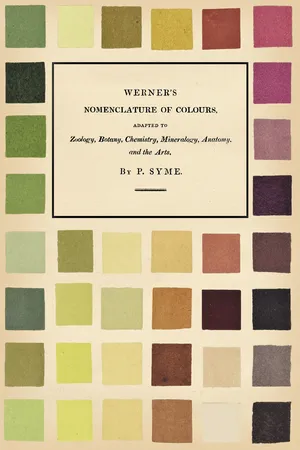
Werner's Nomenclature of Colours
Adapted to Zoology, Botany, Chemistry, Mineralogy, Anatomy, and the Arts
- 80 pages
- English
- ePUB (mobile friendly)
- Available on iOS & Android
Werner's Nomenclature of Colours
Adapted to Zoology, Botany, Chemistry, Mineralogy, Anatomy, and the Arts
About this book
Originally published in 1814, this remarkable volume features 110 colour swatches paired with poetic descriptions that capture nature's vibrant palette.
In the eighteenth century, German geologist Abraham Gottlob Werner (1750-1817) set out to establish a standard reference guide to colour for use in the general sciences. Decades later, Scottish botanical artist Patrick Syme (1774-1845) extended Werner's work, refining it into a comprehensive catalogue of the most prominent shades and hues found in nature. The result was a timeless compendium of colour that showcases the beauty of nature across the animal, vegetable, and mineral kingdoms.
Each colour swatch in Syme's edition of Werner's Nomenclature of Colours is accompanied by examples found in nature, offering a practical tool for scientists, artists, and explorers alike. Notably, Charles Darwin used this guide during his voyage on the HMS Beagle to accurately describe his observations.
This exquisite collection of colours celebrates the harmony of art and science, capturing the beauty found in the natural world.
Frequently asked questions
- Essential is ideal for learners and professionals who enjoy exploring a wide range of subjects. Access the Essential Library with 800,000+ trusted titles and best-sellers across business, personal growth, and the humanities. Includes unlimited reading time and Standard Read Aloud voice.
- Complete: Perfect for advanced learners and researchers needing full, unrestricted access. Unlock 1.4M+ books across hundreds of subjects, including academic and specialized titles. The Complete Plan also includes advanced features like Premium Read Aloud and Research Assistant.
Please note we cannot support devices running on iOS 13 and Android 7 or earlier. Learn more about using the app.
Information
WERNER’S
NOMENCLATURE OF COLOURS.


Table of contents
- Cover
- Title
- Contents
- Werner’s Nomenclature of Colours
- Patrick Syme 1774–1845
- Abraham Gottlob Werner 1749–1817
- Copyright